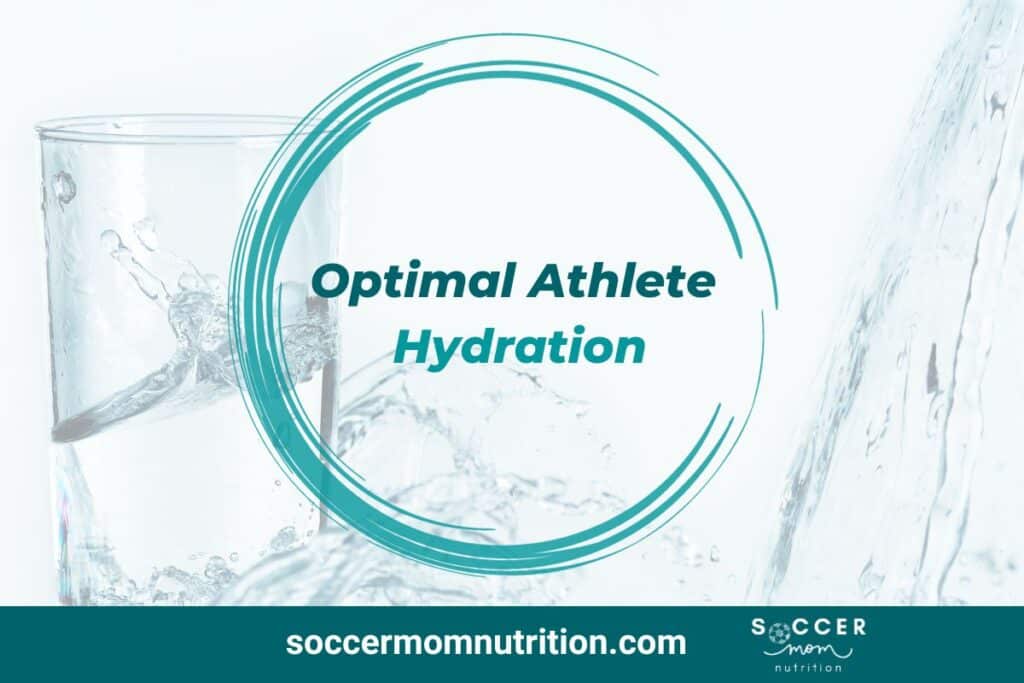Athlete Hydration Tips: How to Hydrate Like a Pro
Athlete hydration is not just about drinking water. It’s about maintaining the right balance of fluids and electrolytes in your body to support your athletic performance and health.
In this blog post, you’ll learn why athlete hydration is essential for performance, how to set your athlete hydration goals and how to monitor and adjust your hydration plan.

Please note that this article contains affiliate links. If you click one of these links and make a purchase, we may earn a commission. As an Amazon Associate, we earn from qualifying purchases.
Why athlete hydration matters
Water is vital for your body functions. It forms around 60% of your body weight and participates in many processes. For example, water builds your blood, fluids, urine, and sweat. It also helps your muscles, fat, and bones.
Moreover, water cools you down, moistens your tissues, lubricates your joints, cleanses your waste, and transports nutrients and oxygen.
Athlete hydration is one of the most important factors that affect your performance. When you’re well hydrated, you can:
- Keep your body temperature stable and prevent overheating
- Deliver oxygen and nutrients to your muscles and brain
- Avoid muscle cramps, fatigue, and headaches
- Recover faster after exercise
On the other hand, when you’re dehydrated you can:
- Experience a drop in blood volume and blood pressure
- Reduce your blood flow and oxygen delivery
- Impair your focus and decision making
- Increase your risk of heat-related illness or injury
Research shows that even a small loss of body water (1-2%) can negatively impact your mood, concentration, and performance. That’s why it’s crucial to have an athlete hydration plan that matches your individual needs and goals.
Goals for athlete hydration
Having a solid athlete hydration plan will help you improve athletic performance, and reduce the risk of heat related illness or injury.
3 key goals for optimized athlete hydration
- Begin training and games well hydrated
- Minimize fluid loss during exercise and avoid excessive dehydration
- Replace remaining losses following exercise prior to the next activity
How to set your athlete hydration goals
Your hydration goals depend on several factors, such as:
- Body weight and composition
- Sweat rate and electrolyte loss
- Exercise intensity and duration
- Environmental conditions (temperature, humidity, altitude)
A general guideline is to drink enough fluids to maintain your body weight within 2% of your pre-exercise weight.
Athlete hydration goals include
- Start your exercise well hydrated by drinking 16-20 ounces of fluid 2-4 hours before exercise
- Minimize your fluid loss during exercise by drinking 4-8 ounces of fluid every 15-20 minutes
- Replace any remaining fluid loss after exercise by drinking 24 ounces of fluid for every pound of body weight lost
Poor athlete hydration status outcomes
Inability to maintain stable body temperature
When you exercise, your body produces heat and sweats to cool down. Sweating is a good thing, but it also makes you lose water and electrolytes. If you don’t drink enough to replace them, your body temperature can rise and make you feel tired and weak.
Your sweat rate can also decrease, making it harder for you to cool down. To avoid this, you should drink fluids before, during and after exercise, and choose fluids that contain electrolytes, such as sports drinks or coconut water.
Restricted blood circulation
Water is essential for transporting oxygen and nutrients to your brain and muscles. When you exercise, your blood vessels widen to allow more blood flow. This helps you perform better by delivering more oxygen and nutrients to the areas that need them most.
However, when you sweat, you lose water from your blood, which can lower your blood volume and pressure. This means that less blood is pumped with each heartbeat and less oxygen reaches your muscles.
To prevent this, you should drink enough water to maintain your blood volume and pressure.
Limited focus and decision making
Research has shown that even a small amount of dehydration (1-2% of body weight) can impair your mood, attention, memory, and judgment. Dehydration can also make you feel thirsty, uncomfortable, and distracted.
This can affect your performance by making you less motivated, alert, and accurate. To avoid this, you should drink water regularly throughout the day, not just when you’re thirsty.
You should also monitor your hydration status by checking the color of your urine (it should be pale yellow) and weighing yourself before and after exercise (you should aim to lose no more than 2% of body weight).
Your hydration status depends on how much fluid you lose and how much you drink during exercise. But fluid loss is not the same for everyone or in every situation. There are several factors that influence how much you sweat and how quickly you dehydrate.
What effects athlete hydration?
Temperature
The hotter it is, the more heat your body produces and the more you sweat. Sweating helps you cool down, but it also makes you lose water and electrolytes.
If you don’t drink enough to replace them, you can become dehydrated and suffer from heat-related illnesses.
Humidity
The more humid it is, the harder it is for your sweat to evaporate. This means your body can’t cool off effectively and you keep sweating more. This also increases your risk of dehydration and overheating.
Sweat rate
This is how much fluid you lose per hour of exercise. It varies from person to person and depends on factors like genetics, fitness level, acclimatization, clothing, and hydration status.
Knowing your sweat rate can help you plan how much fluid you need to drink before, during, and after exercise.
Altitude
The higher you go, the more water you lose through breathing and skin. This is because the air is thinner and drier at altitude and your body has to work harder to get enough oxygen.
You may not feel thirsty, but you can still become dehydrated if you don’t drink enough.
Exercise factors
The longer, harder, and more frequently you exercise, the more fluid and electrolytes you lose. This can make it difficult to keep up with your hydration needs, especially if you don’t have enough breaks or access to fluids.
You may also experience muscle cramps, fatigue, or reduced performance if you don’t replenish what you lose.
Signs of Dehydration
Some people mistake thirst as a trigger to prevent dehydration. However, by the time you feel thirsty you’ve already lost 1-2% of body water. Know the signs of dehydration so that you can help yourself and others.

Additionally you can weigh yourself before practice or a game, keep track of what you drank during the game, then weigh yourself after. If you drank nothing and lost weight, you should plan to incorporate more fluids during activity.
How to assess athlete hydration status
One of the easiest ways to assess hydration status is through urine color. Pale urine typically indicates a well hydrated status. Darker urine means you’re probably dehydrated and you should drink some water or fluids right away.

Check out our sweat rate calculator for more info.
Practical plans for optimal athlete hydration
Remember that all athletes are individuals and should create a hydration plan that works best for them taking into account all the factors discussed in this post.
However, some basic guidelines for athlete hydration can be followed to at least start an athlete off in the right direction.
Fluid intake throughout the day
Don’t wait until you’re thirsty to drink water. Start your day by filling a water bottle and sip it regularly throughout the day. Aim to drink at least two full water bottles as a minimum.
Experiment with different bottle tops or straws to see what makes you drink more. You can also eat foods with high water content, such as fruits, vegetables, soups and yogurt.
Hydrate properly before your activity
To prevent dehydration and improve your performance, you should drink enough water before you exercise. A good rule of thumb is to drink 16-24 oz of water 2-4 hours before your activity.
Then, drink another 8-12 oz of an electrolyte sports drink 1 hour before your activity. This will help balance your electrolytes and give you some quick energy for your muscles.
Hydrate during your activity
To maintain your hydration and prevent fatigue, you should drink fluids regularly during your activity. Try to drink 4-8 oz of fluid every 15-20 minutes of exercise. That’s about four big sips.
Also, take advantage of water breaks whenever you can. If your activity lasts longer than 90 minutes or is very intense, you should also drink 12 oz of a sports drink at halftime or every hour.
This will help replenish the electrolytes and carbohydrates that you lose through sweat.
Rehydrate after your activity
To recover faster and prepare for your next activity, you should drink fluids after you exercise. A good rule of thumb is to drink 24 oz of fluid for every pound of body weight that you lose during exercise.
You can weigh yourself before and after your activity to measure your fluid loss. You should also drink recovery fluids that contain electrolytes and protein, such as chocolate milk, sports drinks, or flavored water.
These fluids will help restore your fluid balance and repair your muscles.
Hyponatremia concerns
Hyponatremia is a rare but serious condition that occurs when the sodium level in your blood is too low. Sodium helps regulate the fluid balance in your body and supports the function of your nerves and muscles.
Normally, your body keeps the sodium level within a healthy range by adjusting how much water you drink, urinate and sweat.
However, sometimes you may drink too much plain water, especially during intense physical activity or in hot and humid weather.
This can dilute the sodium in your blood and cause your cells to swell with excess water. You may feel symptoms such as nausea, vomiting, headache, confusion, fatigue, muscle cramps, seizures, or even coma.
To prevent hyponatremia, you should drink enough water to quench your thirst, but not more than you need. You should also drink fluids that contain electrolytes, such as sports drinks, coconut water or oral rehydration solutions.
These fluids can help replenish the sodium and other minerals that you lose through sweat.
If you suspect that you or someone else has hyponatremia, seek medical attention immediately. Hyponatremia can be life-threatening if not treated promptly.
Final thoughts
Start off following these basic athlete hydration recommendations and fine tune as you go.
You’ll figure out what the best timing is, how your body responds to the increase in fluid and most importantly you should see an improvement in athletic performance and energy.
Join our mailing list and get our FREE Pre-Activity Fueling Guide.
Stephanie Magill, MS, RD, CD, FAND has over 22 years of experience in public health and nutrition. As a performance registered dietitian nutritionist, Stephanie specializes in sports nutrition and provides simple and actionable information so that athletes can be well fueled for high performance on and off the field. Stephanie has a Master’s Degree in Nutrition and is a Fellow of the Academy of Nutrition and Dietetics.

